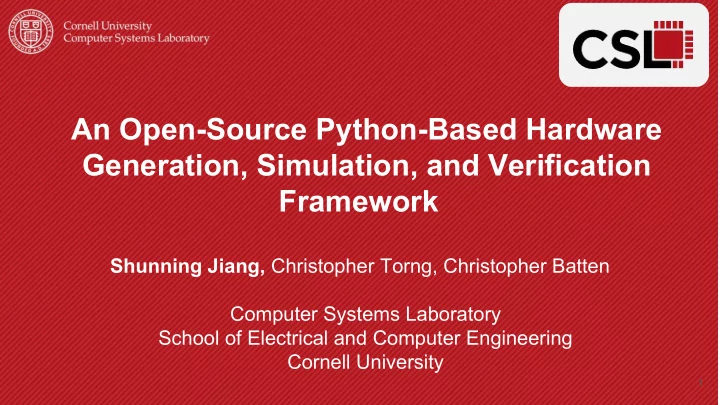

An Open-Source Python-Based Hardware Generation, Simulation, and Verification Framework Shunning Jiang, Christopher Torng, Christopher Batten Computer Systems Laboratory School of Electrical and Computer Engineering Cornell University 1
Outline - Introduction - PyMTL features - PyMTL use cases 1
The Traditional Flow * HDL: hardware description language * DUT: design under test * TB: test bench * synth: synthesis Traditional hardware description language - Example: Verilog Fast edit-debug-sim loop ✓ ✓ Single language for design and testbench X Difficult to parameterize X Require specific ways to 3 build powerful testbench
Hardware Preprocessing Frameworks (HPF) Traditional hardware Hardware preprocessing description language framework (HPF) - Example: Verilog - Example: Genesis2 Fast edit-debug-sim loop ✓ ✓ Better parametrization with ✓ Single language for design insignificant coding style change and testbench X Multiple languages create X Difficult to parameterize “semantic gap” X Require specific ways to X Still not easy to build powerful 4 build powerful testbench testbench
Hardware Generation Frameworks (HGF) Traditional hardware Hardware preprocessing Hardware generation description language framework (HPF) framework (HGF) - Example: Verilog - Example: Genesis2 - Example: Chisel Fast edit-debug-sim loop ✓ ✓ Better parametrization with ✓ Powerful parametrization ✓ Single language for design insignificant coding style change Single language for design ✓ and testbench X Multiple languages create X Slower edit-debug-sim loop X Difficult to parameterize “semantic gap” X Yet still difficult to build X Require specific ways to X Still not easy to build powerful powerful testbench (can only 5 build powerful testbench testbench generate simple testbench)
PyMTL is an Hardware Generation and Simulation framework ✓ Powerful parametrization ✓ Single language for design and testbench ✓ Use host language for verification ✓ Easy to create highly parameterized generators ✓ 5
PyMTL framework 4
Outline - Introduction - PyMTL features - PyMTL use cases
Eight features that make PyMTL productive - Multi-level modeling - Method-based interfaces - Highly parametrized static elaboration - Analysis and transform passes - Pure-Python simulation - Property-based random testing - Python/SystemVerilog integration - Fast simulation speed 9
Multi-level modeling ● Functional-level modeling: quickly building reference model and testbench ● Cycle-level modeling: design space exploration ● Register-transfer-level modeling: generating hardware Example: Accelerator designers only want to implement the accelerator in RTL. How about cache and processor to do end-to-end testing?
Highly parametrized static elaboration PyMTL embeds the DSL into Python, so the hardware designs can use full Python’s expressive power to construct hardware. 6
PyMTL passes PyMTL analysis/transform passes systematically traverse through the design and/or transform the module hierarchy by mutating the internal data structures. 6
Property-based random testing Since the simulation is just executing a piece of Python code, we can leverage random testing frameworks that test Python software for testing hardware. - hypothesis 7
PyMTL/SystemVerilog integration - PyMTL can import SystemVerilog and co-simulate it with the same Python test harness . - PyMTL can also compose multiple PyMTL/SystemVerilog designs and translate the larger design into SystemVerilog. 8
Fast pure-Python simulation With Mamba techniques, the next version of PyMTL gets an order of magnitude of speedup when simulating in a pure-Python environment . - Design the framework from the ground up with a just-in-time compiler in mind - Enhance the just-in-time compiler to recognize critical hardware constructs 9
Outline - Introduction - PyMTL features - PyMTL use cases - PyMTL in teaching: 400+ students across 2 universities - PyMTL in research: four ISCA/MICRO papers use PyMTL - PyMTL in silicon prototyping: three tape-outs, two of which completely use PyMTL
PyMTL in Silicon Prototyping: BRGTC1 (2016) - Fabricated in IBM 130nm - 2mm x 2mm die, 1.2M transistor 10
PyMTL in Silicon Prototyping: BRGTC2 (2018) - Fabricated in TSMC 28nm - 1mm x 1.25mm die, 6.7M transistor - Advertisement: our open-source modular - Quad-core in-order RV32IMAF VLSI build system used in this tapeout 11 https://github.com/cornell-brg/alloy-asic
PyMTL: - Multi-level modeling - Method-based interfaces - Highly parametrized static elaboration - Analysis and transform passes - Pure-Python simulation - Property-based random testing - Python/SystemVerilog integration - Fast simulation speed We expect a new release in 2019. PyMTL: https://github.com/cornell-brg/pymtl Modular ASIC Build system: https://github.com/cornell-brg/alloy-asic 12
Recommend
More recommend